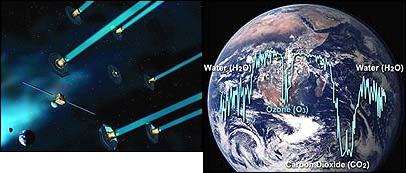A not-so-famous planet, located 42 light-years from here, has risen to the top of the list of life-seeking targets by European astronomers looking for planets that may harbor life

A not-so-famous star, located 42 light-years away, has risen to the top of the list of life-seeking targets by European astronomers looking for planets that might harbor life. The star, which doesn't even have a regular name but only catalog number HD 172051 is similar to our sun, but slightly cooler.
The scientists believe that this is one of the best candidates in the near space to have planets around it that resemble the Earth. This star will be the first major target when Europe launches its Darwin space telescope system next decade.
"This is a good target because it is a planet quite similar to our sun, and therefore if there are Earth-like planets orbiting it, it is possible that they evolved like our Earth and then we can learn a lot about our solar system." says Lisa Kaltenegger, from the European Space Agency's research institute, Estec in the Netherlands. "We will have other candidates for other types of stars but to find a system like ours, this seems to be the best star," she told the BBC.
The Darwin mission is an ambitious plan for the European Space Agency - to place a network of six telescopes 1.5 million kilometers from Earth. The system will look for planets around nearby stars that might support life.
The Darwin launch will only take place in about a decade, but astronomers are starting to prepare the infrastructure and they are preparing a list of 150 target stars. The Darwin catalog will include stars like our Sun (G-type), as well as slightly hotter (F-type) or slightly cooler (K and M) stars. "Darwin will have an amazing ability to look for Earth-like planets where life could develop, around a large number of neighboring stars," Keltenger says. "The system will be able to collect light from the planets themselves and therefore, for the first time, will be able to give us an in-depth look at the conditions on the exoplanets, as well as find planets at all stages of development around their parent star. This way we can piece together the puzzle that will give us an answer to how planets are formed, how our solar system was formed and what variety of planets exists in the universe."
The first step will be to build instruments on the ground to study the target stars using a new technique. By 2006, the European Space Agency ESA and the European Southern Observatory ESO will build Genie (Ground-based European Nulling Interferometer). This array will work together with the Very Large Telescope Array VLT, a collection of four telescopes each 8 meters in diameter , in Chile.
Gini will examine the principles of what is now known as nulling interferometry - combining the signal from a large number of telescopes in such a way that the light from the central star is canceled. In theory, it will be possible to more easily locate planets around other suns - they are much dimmer and therefore they are often drowned in the light of their mother star.
And there will be an added bonus: by collecting light from the planets themselves, Darwin will be able to study their atmospheres, looking for the presence of water, oxygen and carbon dioxide. Finding all three would defeat the purpose, suggesting the possibility of the existence of a certain type of biology that evolved on the planet.
For now the in-depth analysis of HD 172051 will have to wait, but the star, located in the southern part of the sky, in Sagittarius, is already attracting the attention of astronomers. Prof. Martin Barstow (Barstow) from the Department of Physics and Astronomy at the University of Leicester, UK, said that the star is interesting because it is similar to our sun, and is relatively close. "To locate an Earth-sized planet, the best chance is to look at nearby stars," he said. "The best chance of finding a planet with life on it is around a Sun-like star."
